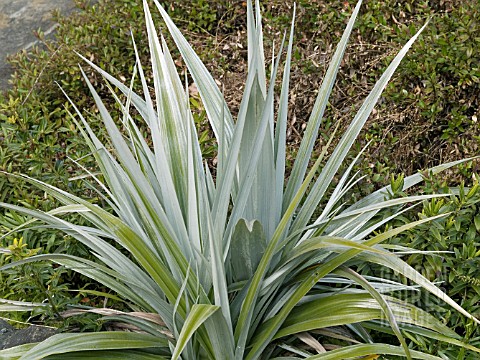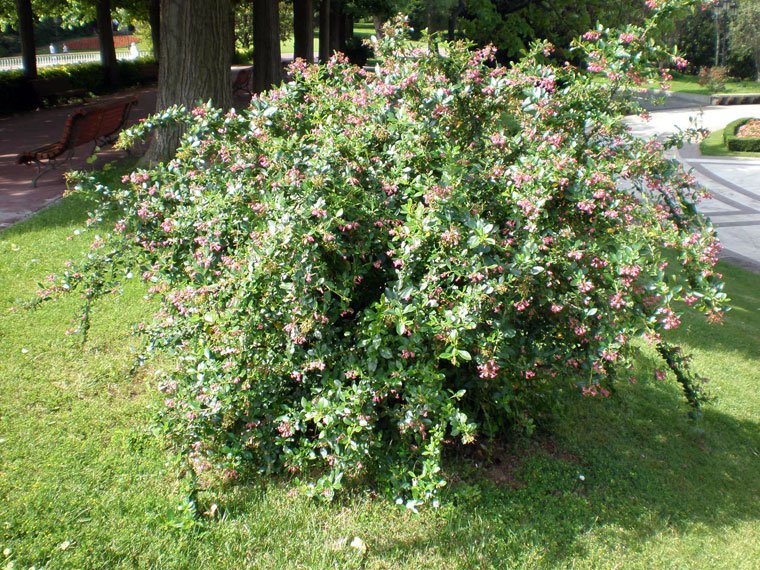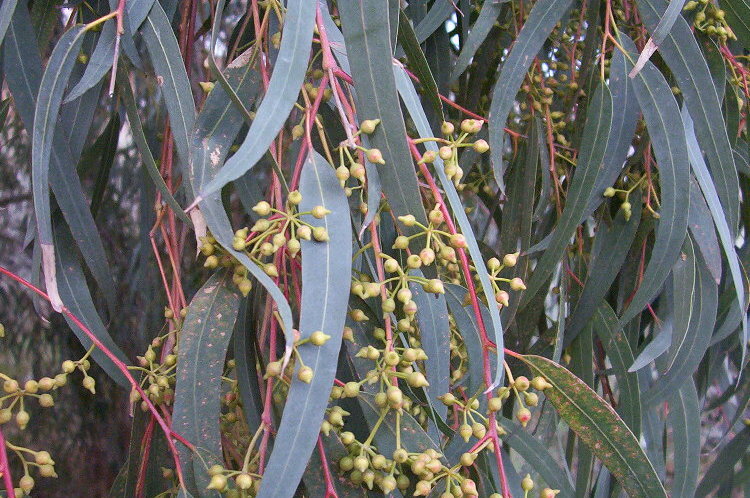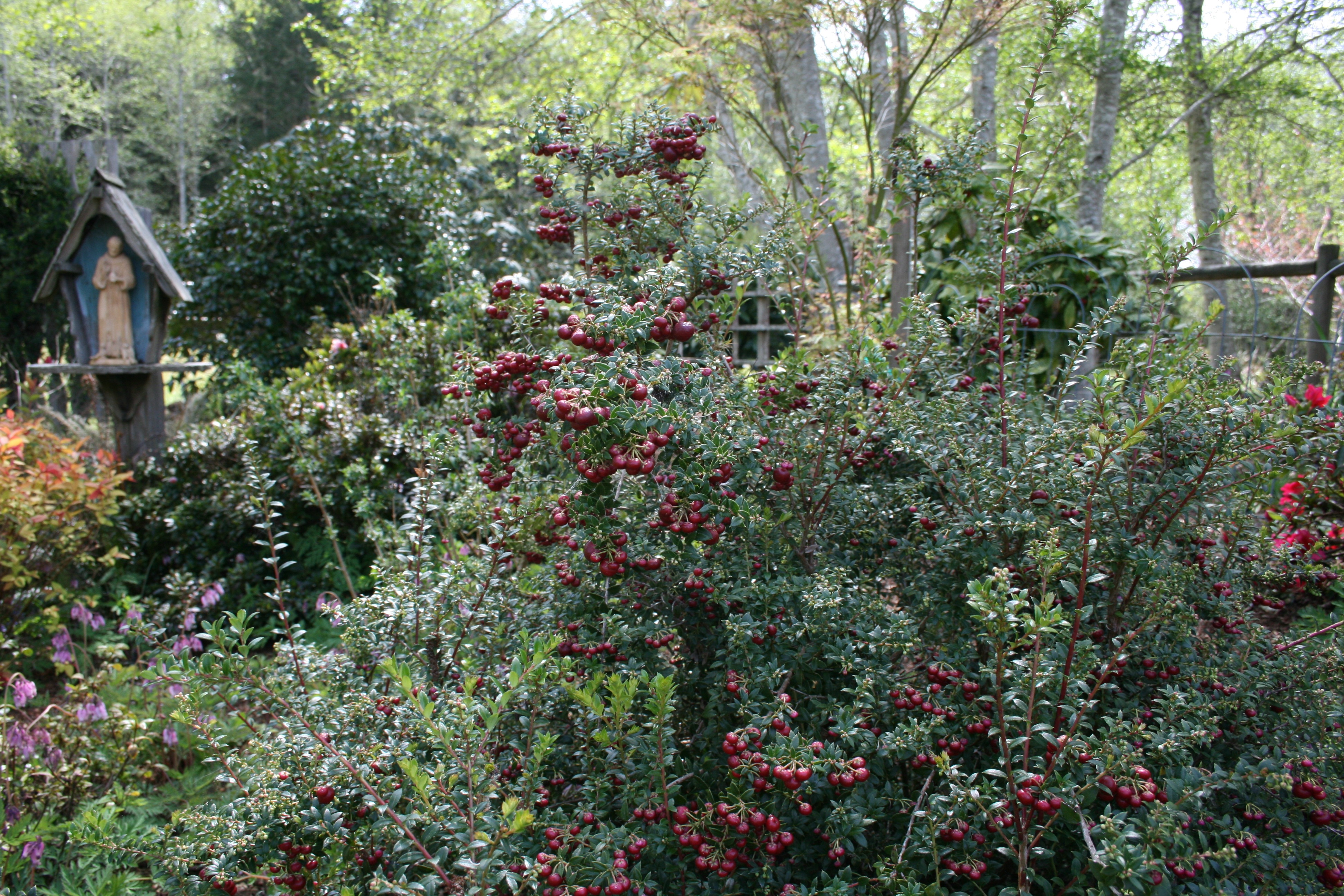Botanical Name: Acaena microphylla
Common Name: New Zealand burr
Family: Rosaceae
Distribution/Origin: New Zealand
Leaf: small, pinnate, bronze to blue green
Bud: opposite
Flower: globular green to red flowers
Fruit/Seed: dense ball of many seeds, attractive
Stem/Bark: brown to green
Size: up to 6” height, 6-9” spread
Habit: creeping, compact
Form: mat forming
Soil conditions: loamy chalky sands, well drained
Moisture: dry to moist
Sun: full sun to partial shade
Exposure: tolerates foot traffic, can be slightly invasive, drought tolerant
Landscape use: borders, banks, slopes, garden patio & container planting,
Notes: seed heads are difficult to detach from clothing, animal fur




Botanical Name: Araucaria araucana
Common Name: monkey puzzle tree, Chilean pine
Family: Araucariaceae
Distribution/Origin: Chile, western Argentina
Leaf: thick, tough, triangular scales, sharpened tips, tight radial arrangement
Bud: epicormic buds
Flower: dioecious, male cones oblong cucumber shaped, female globose cones holding 200 seeds
Fruit/Seed: long nut like seeds from female cones, wind pollinated
Stem/Bark: roughly scaled, grey to brown, sometimes furrowed, scale like leaves on newer growth
Size: 60-130’ height, 30-35’ spread
Habit: single leader, horizontal upwardly arching branching, appear in whorls with rope like branchlets
Form: broadly pyramidal to conical in youth, maturing to umbrella shape/rounded top
Soil conditions: well drained, adaptable, prefers volcanic soils, deep sandy soils
Moisture: evenly moist, dislikes dry hot soils
Sun: full sun to semi shade
Exposure: well adapted to fire and volcanic activity, salt exposure
Landscape use: ornamental, woodland garden canopy, specimen, winter interest
Notes: does not yield seeds until 30-40 years old. Often cited as a living fossil due to the longevity of this tree. National tree of Chile.




Botanical Name: Astelia chathamica
Common Name: silver spear
Family: Asteliaceae
Distribution/Origin: New Zealand
Leaf: linear keeled, silvery green, broad, stiff
Bud:
Flower: panicles of small green to brown flowers
Fruit/Seed: orange berries on female plants
Stem/Bark:
Size: 4-6’ height, 3-4’ spread
Habit: clumping
Form: arching sword shaped leaves
Soil conditions: well drained, loamy clays, fertile, peaty
Moisture: moist, low water requirement once established
Sun: full sun to partial shade
Exposure: sheltered from cold winds and frost, drought tolerant
Landscape use: feature plant, container gardening, massed planting, coastal gardens
Notes: The genus name comes from combining the Greek words 'a' meaning "without" and 'stele' meaning a "trunk" or "pillar"



Botanical Name: Azara microphylla
Common Name: box leaf Azara
Family: Salicaceae
Distribution/Origin: Chile, Argentina
Leaf: evergreen, small simple leaves, often in unequal pairs, shiny dark green,
Bud: opposite, can appear paired
Flower: fragrant creamy yellow flowers, clustered spikes, prominent stamens, vanilla scented
Fruit/Seed: red to black berries
Stem/Bark: exfoliating, light brown to grey, small plates
Size: 13-26’ height, 8-16’ spread
Habit: bushy, open branching
Form: narrowly open, columnar
Soil conditions: well drained, fertile soils, deep, humus rich
Moisture: evenly moist
Sun: full sun to partial shade
Exposure: shelter from cold drying winds
Landscape use: flower borders and beds, wall side borders, city & courtyard gardens
Notes: best time to remove broken or dead branches is after flowering has ended



Botanical Name: Escallonia 'Newport Dwarf'
Common Name: dwarf escallonia
Family: Escalloniaceae
Distribution/Origin: garden origin
Leaf: glossy green, oval, toothed margins, fragrant
Bud: alternate
Flower: blooms on old wood, tubular pink to red blooms, terminal clusters
Fruit/Seed: ornamentally insignificant
Stem/Bark: brown, smooth
Size: 3’ height by 3’ spread
Habit: dense foliage, compact, multi stemmed
Form: mounding
Form: mounding
Soil conditions: average, well drained
Moisture: evenly moist
Sun: full sun to partial shade
Exposure: drought tolerant once established
Landscape use: low hedge, groundcover, mass planting, container, mixed beds
Notes: grows at slow rate




Botanical Name: Cortaderia selloana
Common Name: pampas grass
Family: Poaceae
Distribution/Origin: South America, Pampas region
Distribution/Origin: South America, Pampas region
Leaf: long, slender, sharp edges, linear, bluish green to silvery grey
Bud:
Flower: dense white panicle on tall stems, feathery appearance and texture, pink to white
Fruit/Seed: seeds prolifically, plants will produce up to 1 million seeds in their lifetime
Stem/Bark:
Size: up to 10’ height, 3-4’ spread
Habit: dense tussocks, erect, upright with slight arch
Form: arching mounds, feathery
Soil conditions: average, well drained
Moisture: moist to dry
Sun: full sun
Exposure: tolerant of drought, winds and maritime exposure
Landscape use: xeriscaping, focal point, accent plant,
Notes: considered invasive in some regions (California, Hawaii, Green Spain), in New Zealand and South Africa the plants are banned for propagation and sale for the same reason




Botanical Name: Callistemon citrinus
Common Name: common red bottlebrush, crimson bottlebrush, lemon bottlebrush
Family: Myrtaceae
Distribution/Origin: Australia
Leaf: hard, flat, narrowly egg shaped, pointed tips (not sharp), oil glands visible on leaves
Bud: alternate
Flower: showy red flower spikes, 30-45 stamens red, purple anthers
Fruit/Seed: woody cup shaped capsules
Stem/Bark: hard fibrous or papery bark, in youth covered with soft silky hairs
Size: 3-10’ height, up to 8’ spread
Habit: compact, upright
Form: rounded
Soil conditions: well drained, average, acidic
Moisture: dry to moist
Sun: full sun, will not grow in shade
Exposure: drought tolerant
Landscape use: woodland garden, sunny spots, bog garden, screen, container planting, espalier
Notes: has been renamed Melaleuca citrina




Botanical Name: Escallonia rubra
Common Name: escallonia, crimson spire, red claws
Family: Escalloniaceae
Distribution/Origin: South America, Chile
Leaf: leathery, toothed margins, glossy,
Bud: alternate
Flower: hermaphrodite, 5 petaled, white, pink and red, terminal racemes or panicles
Fruit/Seed: capsules, 20-100 seeds
Stem/Bark: brown peeling bark
Size: up to 11’ height by 8’ spread
Habit: bushy, upright
Form: rounded
Soil conditions: average, well drained
Moisture: dry to moist
Sun: full sun
Exposure: maritime exposure, winds, regular or severe pruning will regenerate from base
Landscape use: hedge
Notes:


Botanical Name: Eucalyptus sp.
Common Name: eucalyptus, gum tree
Family: Myrtaceae
Distribution/Origin: Australia, New Zealand
Leaf: lanceolate, orbicular, entire margins, glaucous, waxy
Bud: alternate or opposite sessile
Flower: perfect, showy, pink, red, yellow and white, stamens give color, fragrant, stamens enclosed in a cap, composed of fused petals and stamens, corymbose
Fruit/Seed: green capsules, look like fairy bongos
Stem/Bark: exfoliating, peeling in strips and chunks, revealing smooth greyish white bark, beautiful!
Size: 23-32’ height, 23-32’ spread
Habit: upright
Form: round
Soil conditions: well drained, average, sandy
Moisture: even moisture, drought tolerant when established
Sun: full sun
Exposure: shelter from cold drying winds
Landscape use: specimen tree, ornamental, large spaces
Notes:




Botanical Name: Eucryphia x nymansensis
Common Name: Nyman's hybrid eucryphia 'Nymansay'
Family: Cunoniaceae
Distribution/Origin: South America, naturally occurring hybrid
Leaf: simple or pinnate leaves, evergreen, shiny/glossy
Bud: opposite
Flower: solitary bowl shaped blooms, papery white, 4 petaled
Fruit/Seed: woody capsule, contains several seeds
Stem/Bark: heavy hard timber, produces good quality charcoal
Size: 20-30’ height, 6-10’ spread
Habit: upright
Form: columnar
Soil conditions: well drained, adaptable, rich, shaded roots
Moisture: even moisture
Sun: full sun to partial shade
Exposure: sheltered from extreme heat
Landscape use: flower borders, beds, wall side, borders, cottage gardens
Notes: highly valued by beekeepers to produce Ulmo honey




Botanical Name: Leptinella squalida
Common Name: brass buttons
Family: Asteraceae
Distribution/Origin: Australia/New Zealand
Leaf: pubescent leaves, fern like, simple, green to bronze, elliptic to obovate, pinnately lobed
Bud: alternate
Flower: capitulum, not showy, yellow
Fruit/Seed: brown achene
Stem/Bark: hairy stems,
Size: 4-8” height, 4-9” spread
Habit: spreading, creeping
Form: mat like
Soil conditions: well drained, humus rich
Moisture: low
Sun: full sun to partial sun
Exposure:
Landscape use: groundcover, alpine garden, container planting, ground cover, mass planting, small space, rock garden
Notes:




Botanical Name: Gaultheria mucronata
Common Name: prickly heath, pernettya
Family: Ericaceae
Distribution/Origin: South America
Leaf: dark green, ovate, glossy, leathery, elliptic to ovate, spine tipped, crenate dentate margins
Bud: alternate
Flower: solitary flowers, 5 petaled, showy, white, spicy scent, urceolate shape
Fruit/Seed: capsule, accessory tissue, color depends on variety (white to black), enclosed in fleshy calyx
Stem/Bark: new stems reddish, platey, exfoliating bark, brownish red
Size: 2-5’ height, 3-5’ spread, moderately fissured, red to brown
Habit: arching, upright
Form: rounded
Soil conditions: acidic, well drained
Moisture: moderate
Sun: filtered sun
Exposure:
Landscape use: group or mass planting, rock garden, small garden space, spring interest
Notes:




Botanical Name: Grevillea victoriae
Common Name: royal grevillea, mountain grevillea
Family: Proteaceae
Distribution/Origin: Australia
Leaf: velvety/fuzzy, gray grey linear
Bud: rust colored drooping flower buds,
Flower: pendant clusters of orange to red flowers, raceme like
Fruit/Seed: FIND FRUIT INFORMATION
Stem/Bark: smooth light brown bark
Size: 6-8’ height, up to 10’ spread
Habit: arching, spreading
Form: erect, upright
Soil conditions: poor/lean, well drained
Moisture: even moisture
Sun: full
Exposure: protect from cold drying winds and heavy frost
Landscape use:
Notes: hardiest of all Grevilleas




Botanical Name: Leptospermum scoparium
Common Name: manuka, manuka myrtle, New Zealand tea tree, broom tea tree, tea tree
Family: Myrtaceae
Distribution/Origin: New Zealand, southeast Australia
Leaf: small, prickly, vary in size and shape, elliptic to broadly lanceolate or obovate, finely crenate margins
Bud: alternate opposite
Flower: white to pink, 5 petaled,
Fruit/Seed: dry capsule
Stem/Bark: tough, hard, flaky light brown to grey, peeling in flakes
Size: 16-50’ height, 8-10’ spread
Size: 16-50’ height, 8-10’ spread
Habit: irregular, sprawling
Form: rounded
Soil conditions: light to medium, average soils, well draining
Moisture: dry to moist
Sun: full shade or sun to dappled shade
Exposure: can tolerate strong winds but not maritime exposure
Landscape use: woodland garden edge, hedges, sunny locations
Notes: name arose from captain Cook using leaves to make a “tea” drink. Cultivated for manuka honey.




Botanical Name: Muehlenbeckia axillaris
Common Name: creeping wire vine
Family: Polygonaceae
Distribution/Origin: Australia, New Zealand, South America
Leaf: small leaves, squarish to roundish shaped
Bud:
Flower: dioecious, racemes of yellowish white flowers
Fruit/Seed: achene, shiny black
Stem/Bark: thin red brown stems
Size: 9-12” height, 5-12” spread
Habit: spreading
Form: creeping, mat like
Soil conditions: gravelly rocky soils, average, well drained
Moisture: moist to dry
Sun: full sun, partial shade
Exposure: drought tolerant, suitable for xeriscaping
Landscape use: groundcover, dappled shade, woodland garden, mass planting
Notes: can smother out plants, will grow up trees




Botanical Name: Podocarpus lawrencii
Common Name: mountain plum pine
Family: Podocarpaceae
Distribution/Origin: Australia
Leaf: green, often tinged red, prominent midrib underneath, small, linear
Bud: alternate opposite, slightly whorled
Flower: small reddish purple catkin, dioecious
Fruit/Seed: long red aril, 1-2 apical seeds
Stem/Bark: new growth is green, brown slightly exfoliating
Size: 24-36” height, 1-2’ spread
Habit: sprawling, creeping, twisted habit when windblown
Form: mat like
Soil conditions: adaptable, well drained
Moisture: moist
Sun: full sun to dappled shade
Exposure: very drought tolerant, can handle cold exposure, can handle winds which give it a gnarled appearance
Landscape use: rock gardens, alpine gardens, house plant, bonsai tree, ground cover
Notes:




Botanical Name: Prostanthera cuneata
Common Name: alpine mint bush
Family: Lamiaceae
Distribution/Origin: Australia
Leaf: small, green, cuneate bases and rounded tips, highly fragrant when touched or bruised
Bud: opposite
Flower: terminal panicles or racemes of white cup like blooms
Fruit/Seed: nutlets
Stem/Bark: brown, square shaped typical of Lamiaceae
Size: 1-2’ height, 2-3’ spread
Habit: spreading, compact
Form: mounding
Soil conditions: well drained, adaptable, average
Moisture: moist to dry
Sun: full sun to light shade
Exposure: extremely drought tolerant
Landscape use: flower borders, beds, wall side borders, cottage gardens
Notes:




Botanical Name: Veronica ochracea
Common Name: hebe, whipcord hebe
Family: Scrophulariaceae/Plantaginaceae
Distribution/Origin: Australia, New Zealand
Leaf: prickly texture, glabrous surfaces, green to yellow, deltoid shaped, entire margins
Bud: opposite
Flower: perfect, raceme, showy white
Fruit/Seed: brown capsule, fruit insignificant
Stem/Bark: prominent lenticels, grey green to brown
Size: 3-4’ height, 3-5’ spread
Habit: arching, upright
Form: round
Soil conditions: acidic, well drained
Moisture: low, moist
Sun: full sun, partial shade
Exposure:
Landscape use: accent plant, filler, group or mass planting, small space, winter interest
Notes:




Botanical Name: Veronica pinguifolia
Common Name: shrubby veronica
Family: Scrophulariaceae
Distribution/Origin: New Zealand, Australia
Leaf: broadly ovate, concave, thick, glaucous
Bud: alternate
Flower: small clusters, white, simple
Fruit/Seed: capsule
Stem/Bark: woody stems, brown peeling bark
Size: up to 3’ height, 2-3’ spread
Habit: erect
Form: rounded
Soil conditions: poor or moderately fertile, well drained
Moisture: moist
Sun: full sun
Exposure: salt and pollution tolerant
Landscape use: borders, groundcover, city or coastal gardens
Notes:


No comments:
Post a Comment